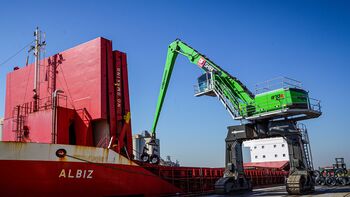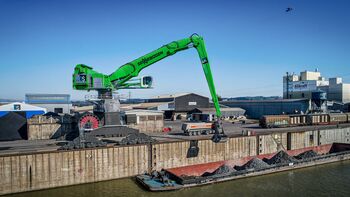BUILD BIG THINGS - SENNEBOGEN cranes supporting the big project "second core S-Bahn route" in the middle of Munich
The Munich S-Bahn carries up to 840,000 passengers daily and covers over 20 million kilometers a year. This makes it one of the largest S-Bahn systems in Germany, whose entire S-Bahn system has to pass under Munich's city center through a tunnel. In order to eliminate this bottleneck, a second core line is being built on behalf of Deutsche Bahn over a distance of around ten kilometers.
The core is a 7 kilometer tunnel linking Munich's main station Hauptbahnhof with the eastern hub Ostbahnhof. The core is a 7 kilometer tunnel linking Munich's main station Hauptbahnhof with the eastern hub Ostbahnhof. Three new underground stations will be built for this purpose: Hauptbahnhof, Marienhof and Ostbahnhof. Like the city itself, the inner-city construction sites are also vibrating. Right in the middlel: two SENNEBOGEN telescopic crawler cranes for 40 t and 120 t load capacity, as well as a SENNEBOGEN crawler crane stage V, which is suitable for lifting work up to 200 t.
In the heart of Munich: tight space conditions at construction site Marienhof
The term "inner-city construction site" takes on a whole new meaning here: the Marienhof construction site is located in the heart of Munich, not far from the Deutsche Oper and Marienplatz. This is where the structural work for the new Marienhof stopping point is currently being carried out, which will in future be located at a depth of about 40 meters. Construction companies within ARGE Marienhof are Implenia Construction GmbH, HOCHTIEF Infrastructure GmbH and Implenia Spezialtiefbau GmbH. Thanks to their green color, the SENNEBOGEN 643 E and 6113 E telescopic crawler cranes, which fully demonstrate the strengths of this crane concept, cannot be overlooked despite the high level of activity:
Particular challenges on the construction site are the tight space conditions, which make it difficult to store material and work with the numerous machines. Due to these conditions, only compact and flexible machines can be used. Other requirements for moving ahead with the construction work as planned are maneuverability and sensitive operation and control. The SENNEBOGEN 6113 E is responsible for the preparatory work for the drill rig by bringing extensions of the drill bit to the machine and lifting retracted drill bits to the storage area. It also unloads the steel reinforcement for the bored piles for storage and then lifts the 6 m long pipes into the borehole. As a flexible crane, it also takes care of the logistics on the construction site by carrying out lifting work for various assembly jobs and storing the required materials.
"The 6113 was chosen because of its lifting capacity in the required radius and its compact design. Above all, its boom, which can be telescoped under load, and the flexibility it offers were convincing," explains Helge Schäfer, Head of Internal Services at sales and service partner Schwab.
The Full-Power Boom can be telescoped under load in any boom length easily and safely via joystick. In addition, thanks to Pick & Carry, it can move the load on the construction site and also reach the furthest corner on the construction site. The telescopic crawler crane shows its strengths wherever loads need to be moved horizontally and vertically: Pipeline work, tunnel construction, hydraulic engineering, civil engineering, bridge construction, wind power, demolition, dismantling, open-cast mining, maintenance, structural engineering, offshore and, as here, in special civil engineering. These cranes can also handle inclinations of up to 4° and declines of up to 20° without any problems.
New station Hauptbahnhof: modern mobility hub
Never before has Munich been built so deep: At the central station, it is now going underground - 65 meters deep, to bring the supporting columns for the new station of the second core line into the earth. This marks the beginning of a new stage in the Munich mega-project.
Right in the middle, a green lattice boom rises into the blue-white Munich sky: the SENNEBOGEN 5500 crawler crane G series, here in the 200 t lifting capacity version. The crane, which had its premiere at bauma 2019 in this configuration, was delivered via sales and service partner Van Den Heuvel to crane rental company Zwagerman VMT, which thus has the state-of-the-art SENNEBOGEN 200 t G-Series crawler crane with the latest stage V engine in its fleet.
In Munich, his task is to lift, set and install the primary supports. One of the major challenges is to set these primary supports with high precision. Here, the robust Star-Lifter crawler undercarriage gives the crawler crane a safe base and the possibility to move comfortably and safely even with up to 90% of the maximum load.
Due to the high variance in the jib configuration, it offers the customer a great variety of applications. The simple and well-arranged design, comprehensible technology and best accessibility to the components save time and costs. The new 5500 G is very compact even in the 200 t version, making it easy to manoeuvre on today's increasingly cramped construction sites. With its standard transport dimensions, it can be easily transported throughout Europe, making it a valuable addition to the Zwagerman VMT BV fleet. Thanks to simple self-assembly, the SENNEBOGEN crawler crane does not require the help of additional superstructure cranes and can be assembled in just a few steps. All components are optimized for cost-saving transport in containers, so assembly is also space-saving.
Diaphragm wall/cut-and-cover construction method for station building
Not only the inner-city location unites both construction sites, but also the so-called diaphragm wall cover construction method is used in the construction of the underground stations Hauptbahnhof and Marienhof. For each station, a deep reinforced concrete wall surrounding the excavation pit is first constructed. The wall consists of a series of slits which are cut into the ground and then filled with concrete. This diaphragm wall is the later outer shell of the station and is required to secure the excavation pit against the existing soil and against groundwater. Within this diaphragm wall the excavation pit for the respective station is extracted. A concrete cover is poured over the excavation pit, the further excavation work will then take place under this concrete cover. Gradually, further soil layers are dug out under the cover and concrete covers are then inserted at certain intervals. These then form the levels of the mezzanine floors and simultaneously brace the excavation pit. At the end of the construction work, the Marienhof will be restored as a green space.
Sources: www.2.stammstrecke-muenchen.de/
Machines in use
Press images
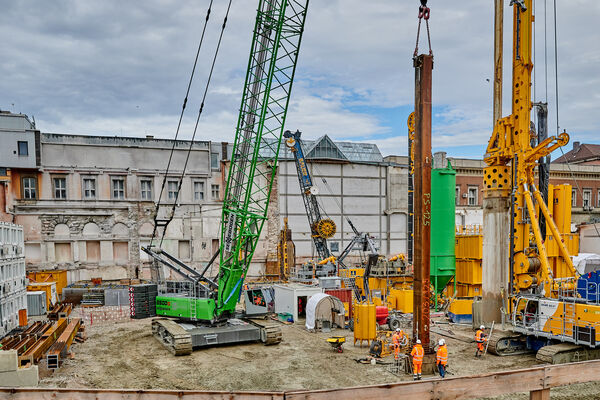


![[Translate to English:] SENNEBOGEN 5500 E Crawler Crawler crane pictogram](/fileadmin/1_Produkte/10_Raupenkran/5500/Piktogramme_Maschinenbeschriftung/5500_e_serie_raupe_NEU_01.png)
![[Translate to English:] [Translate to English:]](/fileadmin/1_Produkte/8_Telekran/6113/Piktogramme_Maschinenbeschriftung/6113_e_serie_raupe_ue.png)
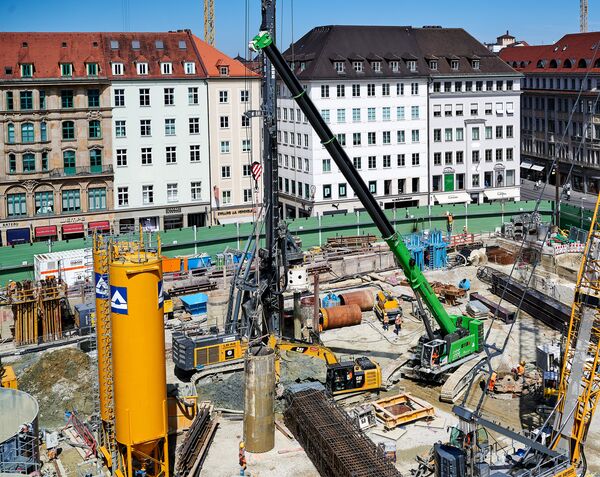
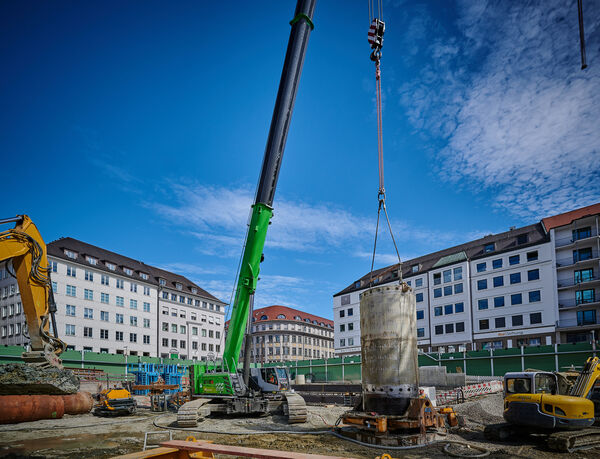
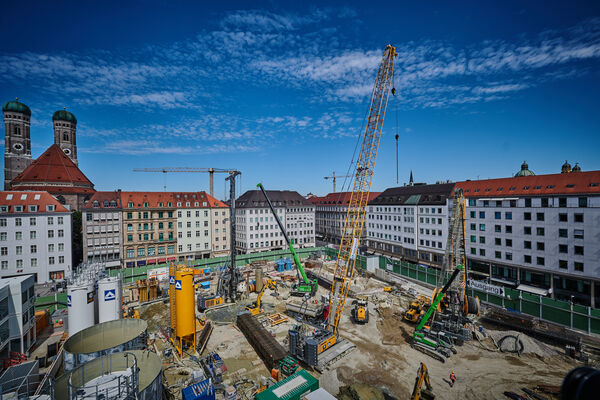
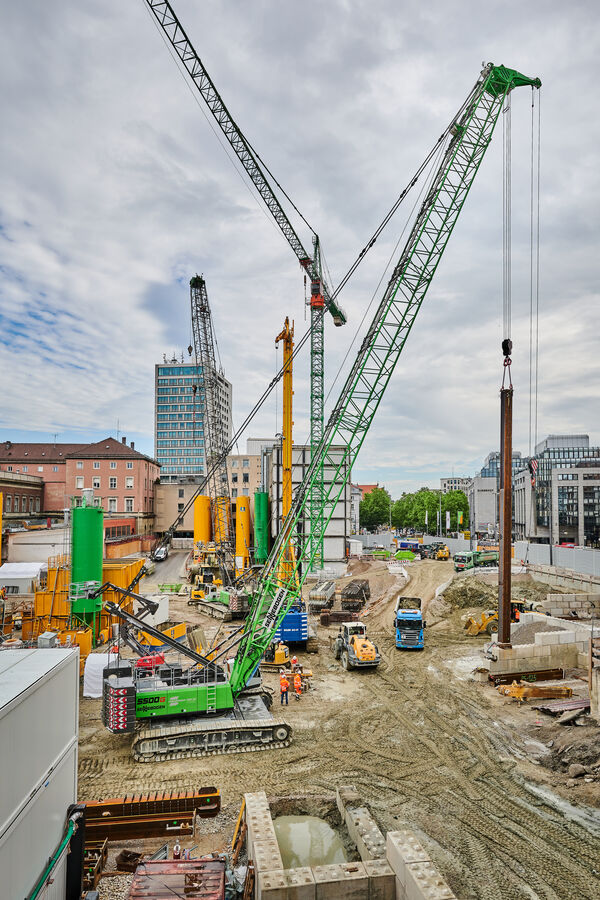
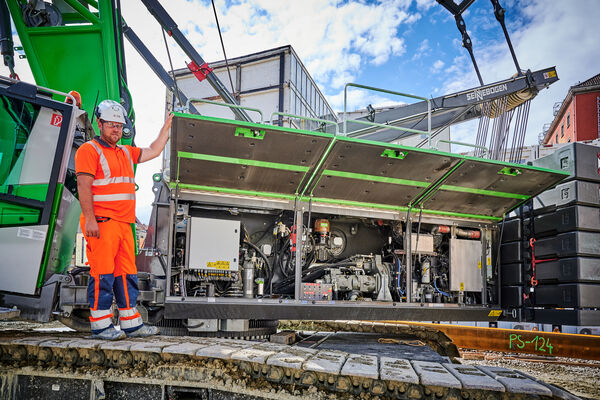
![[Translate to English:] [Translate to English:]](/fileadmin/_processed_/9/e/csm_SENNEBOGEN-355-telescopic_handler-recycling_industry__2__3ce0081c3b.jpg)
